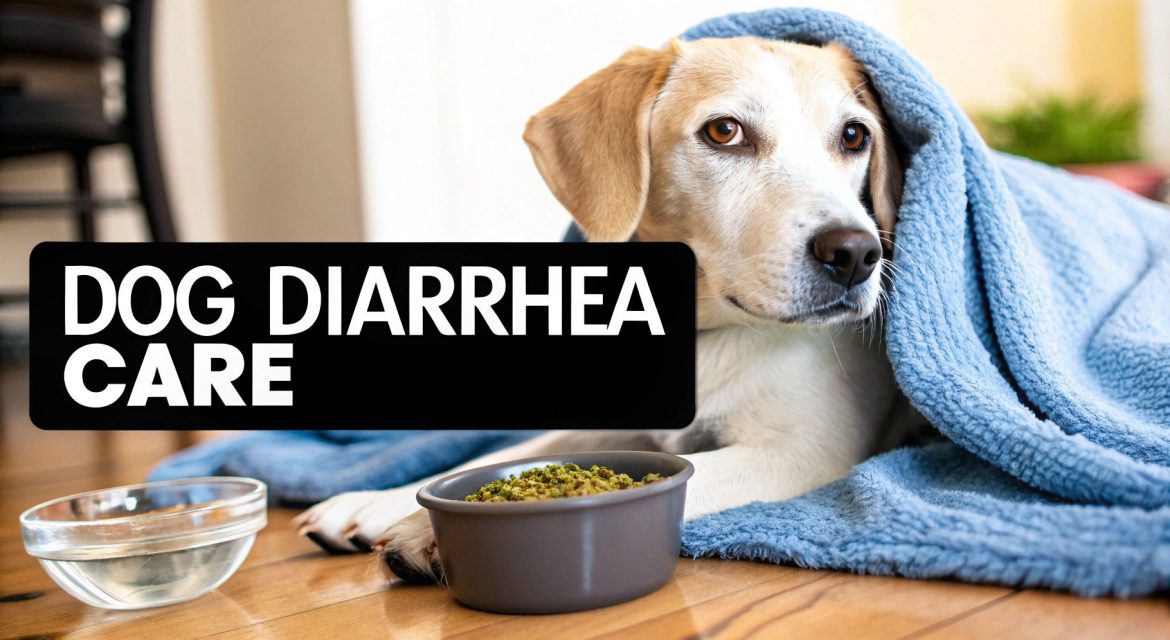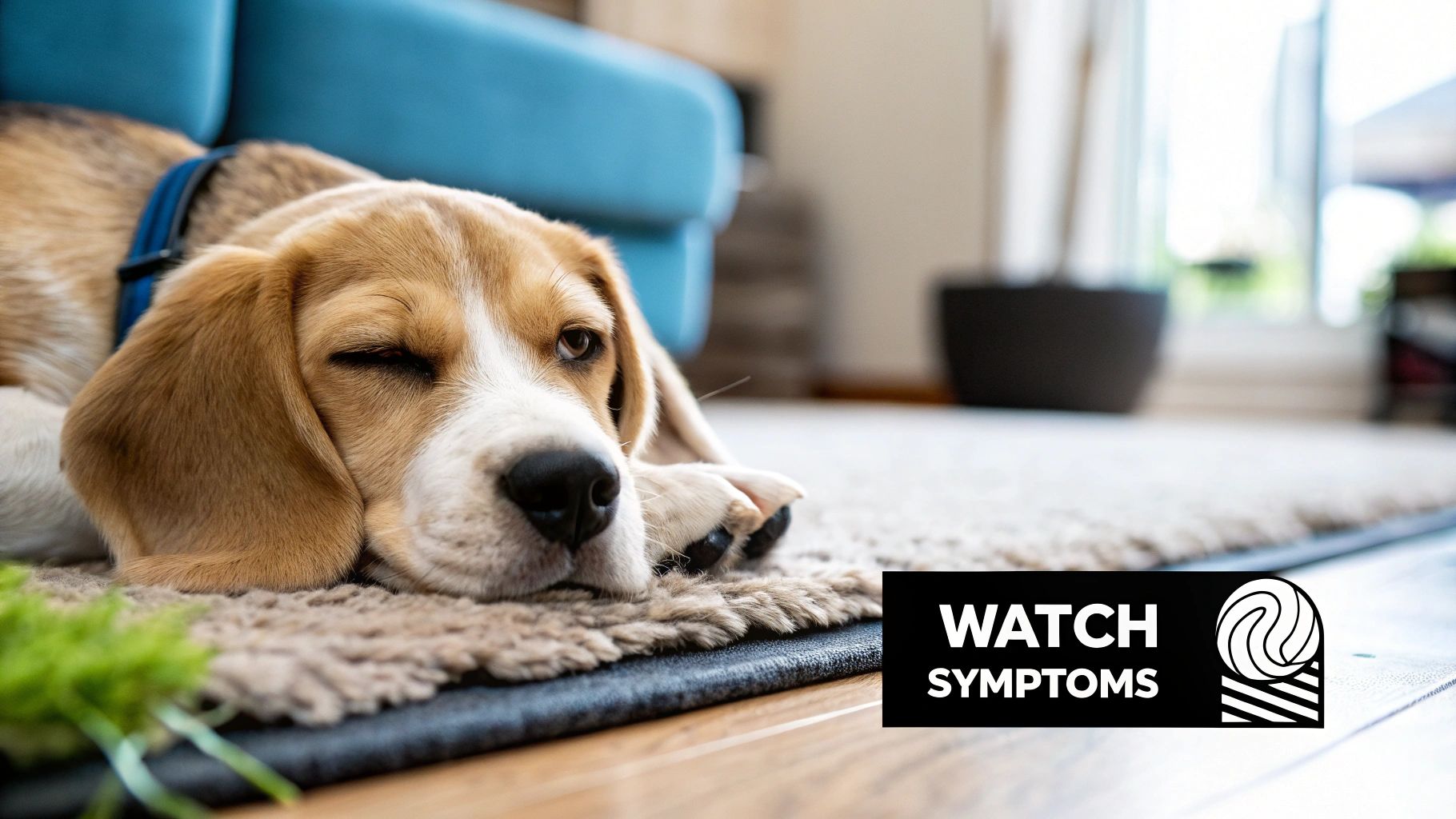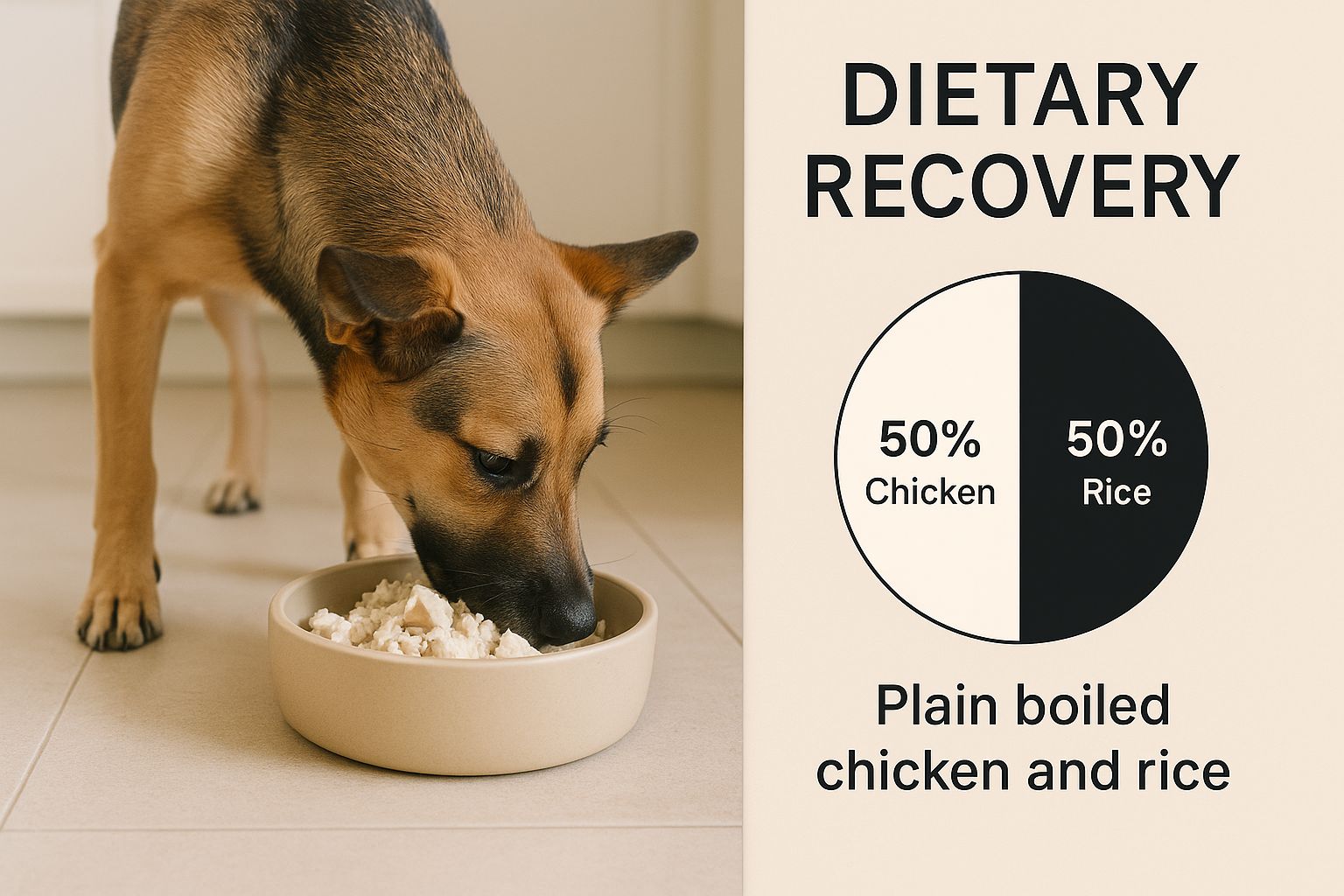When your dog has an upset tummy, that initial wave of panic is completely normal. It’s messy, it’s stressful, and your first thought is always going to be about your best mate's wellbeing. We understand that feeling completely. But here’s the good news: most of the time, it’s a mild issue you can handle right at home, and we're here to guide you through it.
That Sinking Feeling and Your First Steps
It’s a moment every dog owner knows and dreads. You see the signs, your heart sinks, and the worry sets in. That feeling is completely understandable, but you've come to the right place for some calm, clear-headed advice. Let’s work together to swap that panic for a practical plan.
First things first, take a deep breath. You’re definitely not alone in this. Tummy troubles are one of the most common reasons our dogs end up at the vet. In fact, a major UK study from 2019 found that one in every twelve dogs needed vet care for acute diarrhoea that year. The research pointed to some familiar culprits, like scavenging for forbidden snacks or a sudden change in diet. You can explore more about these findings and what they mean for UK dog owners.
Creating a Comfortable Space
Right now, your main goal is to make your companion as comfortable as possible while you keep a close eye on them. It’s all about creating a calm, low-stress environment where they can rest and recover.
Here are a few simple things you can do immediately:
- Ensure easy outdoor access: Let's make those trips outside as frequent and fuss-free as possible.
- Provide fresh water: Dehydration is a real concern, so let's keep their water bowl topped up and clean.
- Set up a cosy spot: Lay down some old towels or blankets in a quiet corner where any accidents are easy to manage.
Your calm and reassuring presence is one of the best things you can offer your dog right now. They can pick up on your stress, so staying composed helps them feel more secure while they're feeling poorly.
By focusing on these initial steps, we shift from a place of worry to one of proactive care. We're here to help you and your beloved dog navigate this together.
So, Why Has My Dog Got Diarrhoea?
Before we can help your dog feel better, we need to play detective. Figuring out why they have an upset tummy is the crucial first step. Think of their digestive system as a finely tuned instrument – it doesn’t take much to knock it off-key.
Often, the answer is simpler than you might think. A quick mental rewind of your dog’s recent activities can reveal some major clues. Once you know what’s gone wrong, you're in a much better position to sort it out and stop it from happening again.
The Usual Suspects: Something They Ate
More often than not, a bout of diarrhoea comes down to one thing: something your dog ate. Their stomachs can be surprisingly delicate, and what seems like a harmless change to us can feel like a seismic event to their gut.
These are the most common dietary culprits:
- A Sudden Food Switch: Did you swap their usual kibble for a new brand without mixing it in slowly? That abrupt change can be too much for their system to handle all at once.
- Dietary Indiscretion: This is the polite way of saying your dog has eaten something they definitely shouldn't have. From a stealthy raid of the kitchen bin to gobbling up a mystery "snack" on a walk, these forbidden feasts are a classic cause of tummy trouble.
- Treat Overload: Too many rich or unfamiliar treats, especially from well-meaning friends or family, can easily overwhelm their digestive system.
Think of your dog's gut as a creature of habit. It gets used to processing the same food day in, day out. When a new or naughty ingredient suddenly shows up, the whole system can get thrown into chaos, leading to the messy results you're now dealing with.
Looking Beyond the Food Bowl
If you're pretty sure your dog hasn't eaten anything out of the ordinary, it’s time to consider other triggers. It’s not just food that can throw their gut's delicate ecosystem out of balance; sometimes, the cause is environmental or even emotional.
Have any of these happened recently?
- Stress or Anxiety: A house move, a new baby, a scary thunderstorm, or even just a major change to their daily routine can trigger stress-induced diarrhoea.
- Drinking Contaminated Water: That quick slurp from a muddy puddle or a stagnant pond during your walk might seem harmless, but it can introduce nasty bacteria or parasites like Giardia into their system.
- Food Allergies or Intolerances: Just like us, dogs can develop sensitivities to certain ingredients over time. Common offenders include beef, dairy, wheat, or chicken, which can cause chronic digestive upset.
By carefully thinking through your dog's last 24-48 hours, you can often pinpoint the likely cause. Did you go anywhere new? Did they eat something different? Was there a stressful event? Answering these questions gives you the power to understand the problem and start putting things right.
Decoding the Signs of Your Dog's Diarrhoea
When your dog gets a bout of diarrhoea, it’s all too easy to just see it as one single, messy problem. But the truth is, not all upset stomachs are created equal. By paying close attention to the details, you become a better advocate for your dog's health, arming yourself with crucial information if you do need to ring the vet.
Think of yourself as a bit of a health detective. The colour, consistency, and frequency of your dog's poo can offer valuable clues about what’s happening inside their body. It’s not the most glamorous job, we know, but learning to ‘read the signs’ is a powerful skill for any dog owner that helps you gauge just how serious the situation is.
Observing More Than Just the Stool
While the diarrhoea itself is the most obvious symptom, it rarely tells the whole story. Your dog’s overall behaviour and other physical signs are just as important. A dog who still has a spring in his step and is eager for a walk is a very different case from one who is listless and refusing to move.
Let's keep a close eye out for these accompanying symptoms:
- Vomiting: Is it happening alongside the diarrhoea? This nasty combination can lead to dehydration much, much faster.
- Lethargy or Weakness: A significant drop in your dog's energy levels is always a red flag that something more serious could be going on.
- Loss of Appetite: If your dog turns their nose up at food or even water, it's a clear signal they are feeling very unwell.
- Signs of Pain: Are they whining, hunching their back, or seeming tender around their abdomen? This indicates discomfort that needs professional attention.
Paying attention to these signals helps you build a complete picture of your dog's health. This detailed observation is exactly the kind of information your vet will need to make an accurate diagnosis and provide the best care.
To help you make sense of it all, here's a quick guide to what different symptoms might indicate. Think of it as a starting point to help you describe the situation clearly to your vet.
Diarrhea Symptom Checker What to Watch For
| Symptom / Type | What It Looks Like | Potential Meaning | Urgency Level |
|---|---|---|---|
| Soft Stool | Still has some shape, like soft-serve ice cream. | Mild dietary upset, stress, or the start of an illness. | Low: Monitor for 24-48 hours. |
| Watery Diarrhea | Liquid, no solid form. Puddle-like. | Could be a viral/bacterial infection, parasites, or a more serious issue. High risk of dehydration. | Moderate: Call the vet if it persists beyond 24 hours. |
| Mucus in Stool | Looks slimy or jelly-like, covering the stool. | Often indicates large intestine inflammation (colitis) or food intolerance. | Low to Moderate: Monitor, but call the vet if it continues. |
| Black, Tarry Stool | Looks like tar, very dark and sticky. | Suggests bleeding in the upper GI tract (stomach, small intestine). This is digested blood. | High: Call your vet immediately. |
| Fresh Blood in Stool | Bright red streaks or drops of blood. | Usually indicates bleeding in the lower GI tract (colon, rectum). Can be from straining. | Moderate: Call your vet for advice. |
| Yellow or Green Stool | Yellowish or greenish in colour. | Often means food is moving through the gut too quickly. Could be a simple upset or a liver/gallbladder issue. | Low to Moderate: Monitor, but call the vet if it doesn't resolve. |
This table isn't for diagnosing your dog at home, but it can certainly help you organise your thoughts and give your vet the best possible information.
Understanding Key Factors Like Breed and Age
It's also important to recognise that some dogs are simply more prone to tummy troubles than others. Recent veterinary research in the UK has shown that certain breeds, including the Maltese, German Shepherd, and Cavapoo, have a higher likelihood of experiencing diarrhoea.
Age is another key factor; dogs under three and those over nine are more susceptible. These findings also noted that vomiting was present in 44% of diarrhoea cases, with lethargy showing up in 24%. You can learn more about how breed and age affect UK dogs to better understand your own dog’s risk factors.
This visual shows a common and effective dietary recovery method for a mild case of dog diarrhoea.
A simple, bland diet like boiled chicken and rice provides easily digestible nutrients that soothe the gut without overwhelming it, helping your companion get back on their paws.
Safe Home Care to Soothe Your Dog's Stomach
When you’re certain your dog is just dealing with a mild case of diarrhoea—and no other worrying symptoms are popping up—you can often provide effective, comforting care right from your own kitchen. It can feel so empowering to know you have the tools to help your friend feel better.
Let's walk through the gentle, vet-approved steps to soothe their tummy and get them back on track. The first and most important step is to give their digestive system a much-needed break. It might feel wrong to withhold food, but this is a crucial reset.
Step 1: Start with a Brief Gut Rest
Think of your dog's gut like a busy factory that’s been overloaded and has ground to a halt. The best way to get it running smoothly again is to temporarily shut down production. For most healthy adult dogs, this means no food for 12-24 hours.
This short fasting period allows the inflamed intestines to rest and recover without the stress of digesting more food. It helps reduce inflammation and gives the gut a chance to heal itself.
It's vital to remember that this step is only for healthy adult dogs. Puppies and senior dogs have different metabolic needs and should never be fasted without direct veterinary guidance. During this time, water is not just allowed—it's essential.
Step 2: Focus on Hydration
While food is on hold, water is the absolute top priority. Diarrhoea causes a significant loss of fluids, and dehydration is a real and serious risk. Your job is to make sure your dog keeps drinking, even if they don't feel much like it.
Here are a few tips to encourage them:
- Keep the bowl fresh: Make sure their water bowl is sparkling clean and filled with fresh, cool water at all times.
- Offer ice cubes: Some dogs find licking ice cubes more appealing than drinking from a bowl, especially if they feel a bit nauseous.
- Try bone broth: A small amount of plain, unsalted bone broth (with no onions or garlic!) can entice a reluctant drinker with its appealing smell and flavour.
Keeping them hydrated is a non-negotiable part of home care. If your dog refuses to drink anything for an extended period, you need to contact your vet.
Step 3: Reintroduce a Bland Diet
After the 12-24 hour rest period, you can start reintroducing food—but definitely not their usual kibble. This is where the classic bland diet comes into play. Its purpose is to be incredibly easy to digest, providing gentle nutrition without putting any strain on their recovering gut.
The go-to recipe is beautifully simple:
- Boiled Chicken: Use boneless, skinless chicken breast. Boil it until cooked through, then shred it into small, manageable pieces.
- Plain White Rice: Cook plain white rice until it's soft and a bit mushy. Avoid brown rice for now; its higher fibre content can be too harsh on a sensitive stomach.
Start by offering a tiny portion, about a quarter of their normal meal size. If they keep this down without any further issues, you can offer another small meal a few hours later. Over the next two to three days, you can gradually increase the portion size and slowly start mixing their regular food back in. To explore more options for sensitive stomachs, check out our guide on choosing the best dog food for diarrhea.
When to Call the Vet: Red Flags You Cannot Ignore
Home care is a fantastic first line of defence when your dog has diarrhoea, but it’s not a cure-all. Your intuition as a dog owner is a powerful thing. If that little voice in your head is telling you something is seriously wrong, you should always listen. Knowing the difference between a mild tummy upset and a genuine emergency is crucial for your dog's safety.
This isn't about causing alarm; it's about empowering you to act decisively when it truly matters. Let’s walk through the unmistakable red flags that mean it’s time to stop the home remedies and pick up the phone to your vet.
Critical Warning Signs
If you spot any of the following, please don't wait and see. These symptoms can point to more serious underlying issues that need immediate professional attention.
A few signs stand out as particularly urgent:
- Blood in the Stool: This includes bright red streaks, which signal fresh blood, or dark, black, tarry stools, which indicate digested blood.
- Persistent Vomiting: If your dog is vomiting repeatedly, especially if they can't even keep water down, the risk of dehydration skyrockets.
- Extreme Lethargy or Weakness: A dog that is unusually tired, weak, or completely unresponsive is telling you something is very wrong.
- Signs of Pain: Watch for a hunched-over posture, whining, a tense or bloated abdomen, or a reluctance to be touched around their belly.
These signs are your dog's way of sending out an S.O.S. signal. While it's easy to want to wait it out, prompt veterinary care in these situations can make all the difference to a positive outcome.
When Time Is a Factor
Sometimes, the biggest red flag is simply how long the problem has been going on. A mild dietary slip-up should resolve fairly quickly with a bland diet and some rest. If it doesn't, that's a sign that something more is happening beneath the surface.
The 48-hour rule is a reliable guideline here. If your dog's diarrhoea hasn't shown significant improvement after two full days of careful home management, it's time for a professional opinion. This is especially true if you also notice they're losing weight or refusing to eat.
Vulnerable Dogs Need Faster Action
Age and health status play a massive role in how you should respond. The "wait and see" approach is much riskier for certain dogs who simply have fewer reserves to fight off illness.
You should call your vet much sooner—often right away—if the dog with diarrhoea is:
- A puppy
- A senior dog
- A dog with a pre-existing health condition (like diabetes or kidney disease)
These dogs can become dehydrated or dangerously ill much faster than a healthy adult dog. You can learn more about how to spot the early signs of dehydration in dogs in our detailed guide.
Interestingly, many cases of diarrhoea never even make it to the vet's office. Owner-reported data shows that while 8.18% of dogs seen in UK primary care in 2019 had acute diarrhoea, only about 37% of owners actually take their dog to the vet for it. This suggests the issue is far more common than clinical records show, and you can discover more insights about these UK findings to understand the broader context.
Answering Your Questions About Dog Diarrhoea
When you’re worried sick because your dog has an upset stomach, your mind can race with a hundred different questions. It's completely normal to feel a bit overwhelmed and unsure about what to do next. We get it, and we’ve been there too.
To help give you some extra confidence, we’ve gathered the most common questions we hear from fellow dog owners and provided clear, straightforward answers. Sometimes, just having that direct answer can make all the difference, helping you feel more in control.
How Long Can a Dog Have Diarrhoea Before Seeing a Vet?
This is usually the first question that pops into our heads. For a generally healthy adult dog with a mild case, it’s reasonable to try home care strategies for 24-48 hours. During this window, you should be watching closely for any signs of improvement.
However, if things aren’t getting better within those two days, it’s time to call the vet. You should also call immediately if your dog seems unwell in any other way—like being extremely lethargic, vomiting repeatedly, or refusing to drink water. Any diarrhoea that drags on for weeks is considered chronic and always needs a professional to uncover the root cause.
The two-day rule is a great guideline for mild cases. But remember, your intuition is key. If you feel something is seriously wrong before the 48-hour mark, always trust your gut and make that call.
Should I Give My Dog Human Medicine for Diarrhoea?
It can be so tempting to reach into your own medicine cabinet for a quick fix, but this is a firm no. You should never give your dog human medications like Imodium or Pepto-Bismol without explicit instructions from your vet.
Many human drugs are toxic to dogs. Even those that are sometimes used in veterinary medicine require a very specific diagnosis and a precise dosage to be safe. Giving the wrong medication or an incorrect dose can cause significant harm and make a bad situation much worse. It’s a risk that’s simply not worth taking.
What Can I Do to Prevent Diarrhoea in My Dog?
While you can't bubble-wrap your dog and prevent every single tummy upset, consistency is your most powerful tool. Building a stable and predictable routine for their gut is the best defence you have.
Here are a few key preventative measures:
- Stick to a Stable Diet: Feed a high-quality food that agrees with your dog and avoid making sudden changes. If you do switch foods, do it gradually over a week or more.
- Prevent Scavenging: Keep your bins secure and teach a reliable "leave it" command for walks. This stops them from eating things they really shouldn’t.
- Keep Health Checks Current: Stay on top of your dog's vaccinations and deworming treatments, as parasites are a common culprit.
- Provide Clean Water: Always ensure they have access to fresh, clean water, especially when you're out and about, to discourage them from drinking from puddles.
For more tips on maintaining your companion's overall wellness, you can explore our comprehensive guides on dog health and care.
Is Canned Pumpkin Good for a Dog with Diarrhoea?
Yes, it can be! One hundred percent pure canned pumpkin (not the sugary pie filling) is a fantastic source of soluble fibre. This type of fibre works by absorbing excess water in the gut, which can help to firm up their stool.
Think of it as a gentle, natural supporting act for their recovery, not a cure-all. You can add a small amount to their bland diet—a good rule of thumb is about one teaspoon per meal for small dogs and one tablespoon for larger dogs. It’s a simple trick that can often make a real difference in mild cases.
At My Life My Dog, we're dedicated to giving you the clear, reliable information you need to care for your canine companion with confidence. For more expert advice on everything from nutrition to training, visit us at https://mylifemydog.com.







